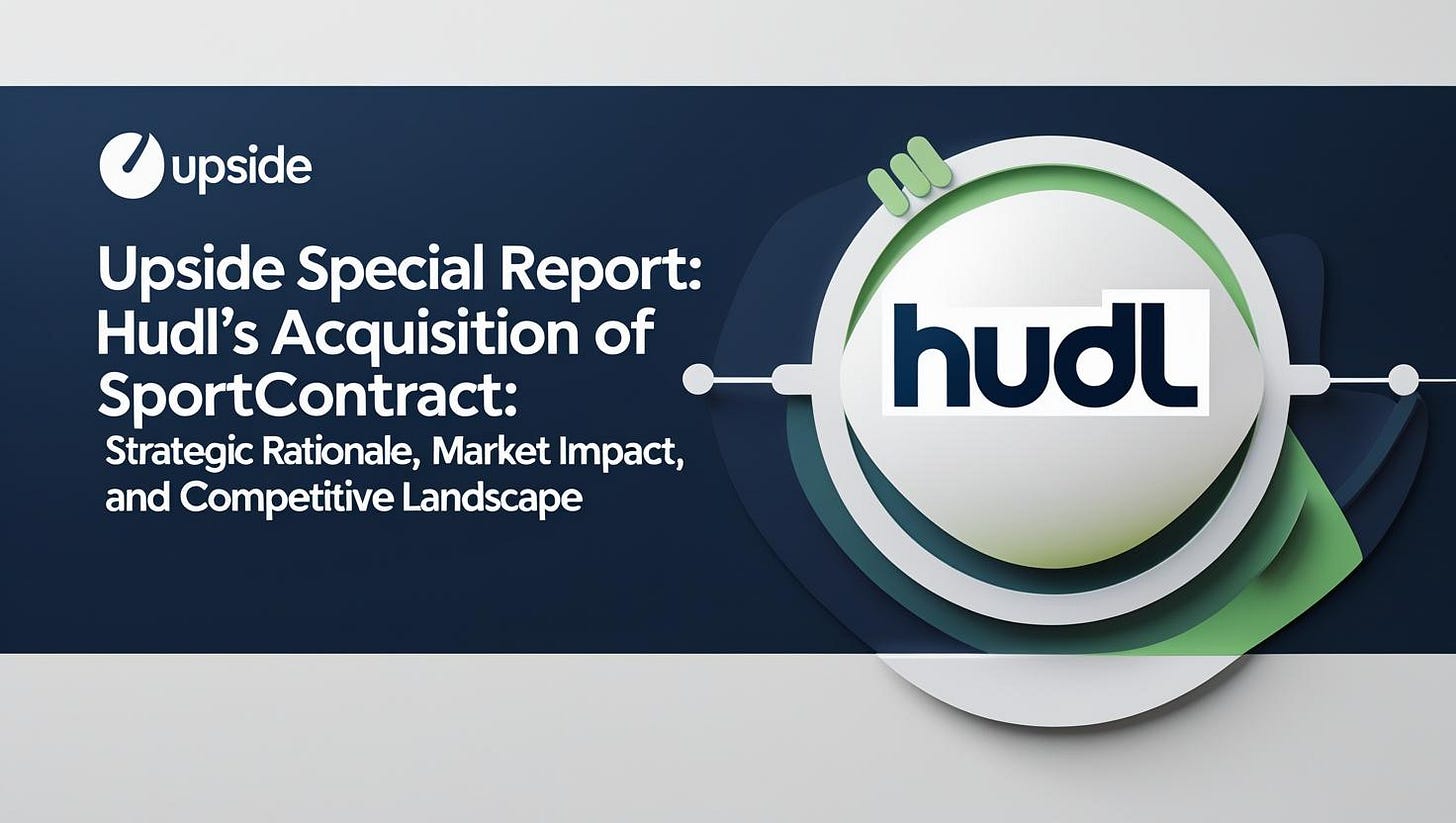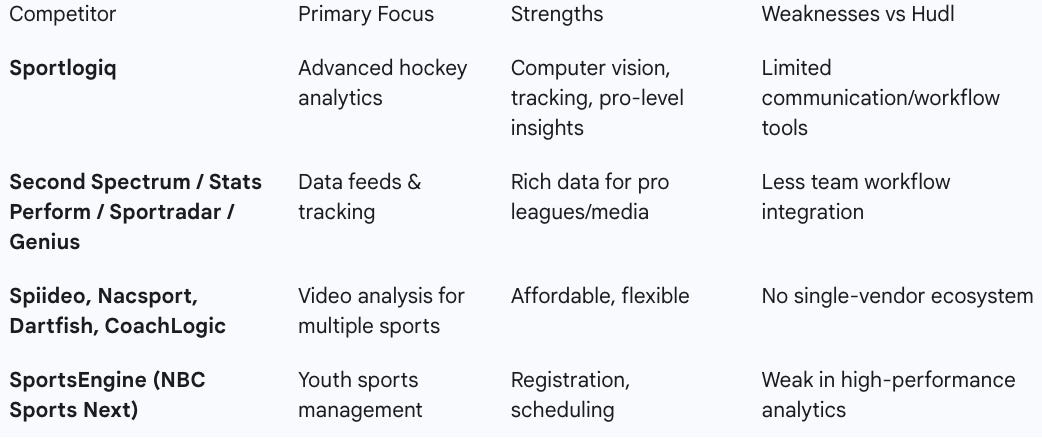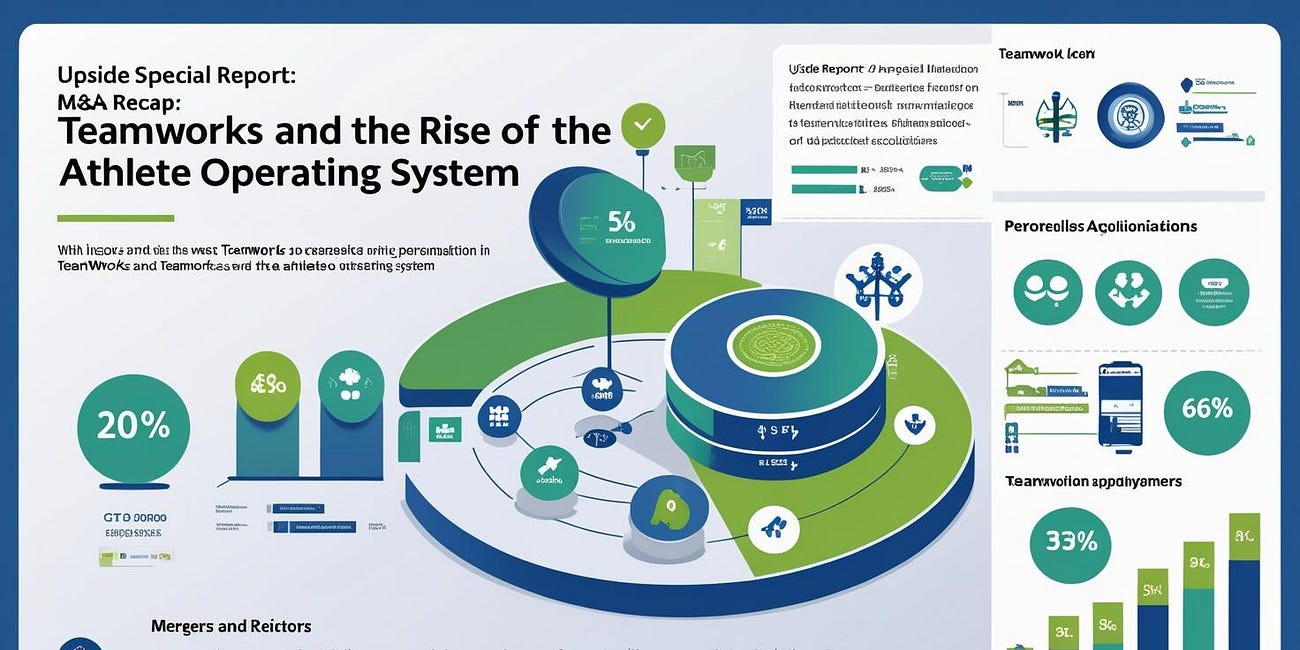📚 Upside Special Report: Hudl’s Acquisition of SportContract: Strategic Rationale, Market Impact, and Competitive Landscape
Hudl, the global leader in cloud-based video and data tools for sports organizations, recently announced the acquisition of SportContract, a hockey-first software platform designed to streamline video, data, and communication workflows for both professional and youth hockey teams. While terms of the deal were not disclosed, this move strengthens Hudl’s foothold in the hockey vertical and aligns with its long-term vision of offering sport-specific, end-to-end performance ecosystems.
This acquisition is part of a broader consolidation trend in the sports technology industry, where multi-sport platform providers acquire niche, high-performing solutions to deepen their domain expertise and reduce fragmentation in the market.
Hudl’s Previous Acquisitions and Strategy
Hudl has consistently grown through acquisitions, targeting companies that:
Expand into new sports verticals (e.g., Wyscout for soccer scouting and recruiting)
Add innovative video capture or analysis tech (e.g., Krossover for breakdown automation)
Enhance coaching communication and athlete engagement (e.g., Ubersense, VolleyMetrics)
Improve recruiting visibility (e.g., Recruit.me)
Expand global reach (e.g., Sideline Video Service in Australia)
Each acquisition has followed a familiar pattern:
Acquire a specialist with deep vertical expertise
Integrate workflows into Hudl’s ecosystem
Leverage Hudl’s scale to drive adoption across levels
SportContract fits squarely into this blueprint — offering a hockey-specific workflow platform with communication and data layers that complement Hudl’s video backbone.
Rationale for the SportContract Acquisition
Strategic drivers:
Vertical depth in hockey — Hockey requires unique workflows for scouting, video review, and development; SportContract already has these embedded.
End-to-end team operations — Combines video, communication, and data in a single environment.
Youth-to-pro pipeline — Positioning Hudl as the default solution from grassroots clubs to the NHL.
Increased stickiness — By absorbing the full workflow, Hudl increases switching costs for customers.
Competitive Impact and Market Positioning
Immediate Market Effect
Hudl now owns a turnkey hockey operations suite — video capture, tagging, analysis, communication, and roster management — which raises the competitive bar. Rival vendors must respond with either specialized, deeper analytics or broader integrated platforms.
Competitor Positioning
Source: Upside Global, August 2025
The competitive landscape for hockey technology platforms is diverse, with each vendor focusing on distinct aspects of the overall performance and operations workflow.
Sportlogiq stands out as a specialist in advanced hockey analytics, leveraging computer vision and AI to provide detailed tracking and event data primarily aimed at professional teams and broadcasters. Their strength lies in deep, data-driven insights rather than integrated communication or workflow tools.
Second Spectrum, Stats Perform, Sportradar, and Genius primarily deliver comprehensive data feeds, player tracking, and broadcast enhancements. These firms excel in producing rich datasets and media integrations but typically do not offer full team workflow or communication platforms.
Spiideo, Nacsport, Dartfish, CoachLogic, and Kinovea focus on video capture and analysis across multiple sports, including hockey. They often provide flexible and affordable point solutions for clubs and academies but lack the cohesive, all-in-one ecosystems Hudl is building.
SportsEngine (part of NBC Sports Next) caters mainly to youth sports management with features like registration and scheduling, offering limited high-performance or professional analytics capabilities.
In summary, Hudl’s acquisition of SportContract strengthens its position as a provider of a comprehensive, end-to-end platform that covers everything from video capture to team communication and scouting. In contrast, many competitors focus either on specialized analytics or point solutions without the same level of integration, making Hudl uniquely positioned to deliver a unified workflow experience that appeals to teams seeking operational efficiency and scalability.
Likely Competitor Responses
In reaction to Hudl’s acquisition of SportContract, competitors across the sports tech landscape are expected to recalibrate their strategies to maintain relevance and market share. The consolidation represents a challenge to vendors offering either specialized or fragmented solutions, pushing them to evolve in several key ways:
Doubling down on analytics specialization:
Companies like Sportlogiq, which focus heavily on advanced hockey analytics driven by computer vision and AI, will likely sharpen their proprietary models to deliver insights that go beyond Hudl’s integrated workflow offerings. By innovating in predictive metrics such as expected goals (xG), expected threat (xT), and player tracking data, these firms aim to serve elite professional teams and broadcasters who demand cutting-edge analysis not yet commoditized within full-stack platforms.Forging strategic partnerships and integrations:
Data-centric providers such as Stats Perform, Sportradar, and Second Spectrum might deepen their API-based partnerships with Hudl or other platforms to ensure their rich data feeds and broadcast-quality tracking are accessible within popular team management ecosystems. This approach allows them to remain integral to performance workflows without directly competing on end-user experience or communication layers, leveraging mutual benefits rather than head-to-head competition.Accelerating mergers and acquisitions:
Mid-sized or niche vendors in video analysis, communication, or performance monitoring may seek their own M&A opportunities to build out more comprehensive suites of services, thereby competing with Hudl’s expanding ecosystem. Historical precedents from SportsEngine and Hudl’s own acquisitive playbook suggest a trend toward vertical integration where companies combine scouting, analytics, communication, and recruitment into unified platforms.Competing on pricing, service, and federation relationships:
Smaller vendors and regional players might focus on winning youth sports federations or amateur clubs through more competitive pricing, customized service agreements, or white-label solutions. They may leverage their agility and localized knowledge to undercut Hudl’s broad but possibly less tailored offerings, particularly where scale advantages are less critical.Doubling down on vertical specialization for elite teams:
Vendors could further specialize in highly bespoke features tailored to specific coaching styles, scouting methods, or medical performance workflows that are more difficult for a broad platform like Hudl to replicate quickly. By integrating tightly with physiological data, biomechanics, or sport-specific tactical tools, these companies hope to maintain a defensible niche in the elite sports technology stack.
Strategic Implications for Buyers (Teams, Leagues, and Federations)
For teams, leagues, and federations navigating this evolving marketplace, Hudl’s consolidation move brings a mix of opportunities and challenges:
Operational efficiency and simplification:
By consolidating key workflows—video capture, analysis, scouting, communication, and recruitment—under one vendor, organizations can reduce the complexity and costs associated with managing multiple platforms. A unified ecosystem facilitates smoother data flow, less IT overhead, and streamlined staff training. This can be especially valuable for youth programs and mid-level professional teams with limited technical resources.Potential risks of vendor lock-in:
While a single-vendor solution offers convenience, it also introduces risks if that vendor’s roadmap or service quality declines. Organizations must carefully evaluate contracts and demand clear data export and migration rights to avoid being locked into one ecosystem without flexibility.Higher expectations for turnkey delivery:
As the market consolidates, teams will expect platforms to deliver comprehensive solutions rather than piecemeal tools. This shifts vendor selection criteria toward integrated product suites with strong user experience, regular updates, and responsive support. Providers unable to meet these expectations may lose share rapidly.Continued role for best-of-breed vendors:
Despite the trend toward consolidation, many elite teams and federations will still require advanced analytics or niche tools that large platforms may not provide at the same depth. In these cases, the ability to integrate multiple vendors seamlessly via open APIs or data-sharing agreements becomes a critical procurement factor.Strategic procurement considerations:
Buyers should emphasize negotiating federation-level agreements that leverage economies of scale, including service-level agreements (SLAs) and technology roadmaps that align with organizational goals. They should also build IT strategies that prioritize interoperability and vendor-neutral data standards to future-proof investments.Monitoring evolving market dynamics:
Teams and leagues must stay informed about emerging players, platform upgrades, and potential new acquisitions. Proactive technology scouting and internal stakeholder engagement can ensure that organizations adopt tools that best fit their evolving competitive and operational needs.
Here is a quick summary of the implications for buyers:
Efficiency gain from fewer vendors — but must watch vendor lock-in
Greater expectation for turnkey delivery — more clubs will demand one-stop solutions
Best-of-breed still viable — advanced analytics firms remain relevant for elite users if well-integrated
Why It Matters for the Competition
This acquisition is significant because it shifts the basis of competition from individual features to ecosystem value. Hudl is positioning itself as the operating system of performance and scouting in multiple sports.
In hockey: Hudl now challenges Sportlogiq and Spiideo not just on video analysis but on the entire workflow.
Across sports: It signals Hudl’s readiness to repeat the model in other verticals, potentially targeting lacrosse, rugby, or niche Olympic sports.
Competitors without a full-stack product will face pressure to either integrate or be acquired.
Recommendations for Teams
Short-term:
Audit current video, data, and communication workflows
Evaluate vendor lock-in risks
Demand clear data portability from all vendors
Medium-term:
Consider hybrid stacks (Hudl for workflow + specialist analytics tool)
Negotiate federation-wide pricing where possible
Monitor vendor consolidation for integration opportunities
Conclusion
Hudl’s acquisition of SportContract is more than a hockey play — it’s another step toward owning sport-specific performance ecosystems. In the near term, it enhances Hudl’s hockey product; in the long term, it strengthens Hudl’s ability to be the default platform from youth to pro in multiple sports. Competitors will have to choose between deep specialization and ecosystem building, while teams must balance efficiency gains with strategic flexibility.
You may also like:
📈 Upside Special M&A Report: Teamworks and the Rise of the Athlete Operating System
Over the past decade, Teamworks has evolved from a digital communication tool for college athletes into a global SaaS powerhouse supporting over 6,000 sports organizations across the NCAA, NFL, NBA, NHL, MLB, Premier League, and military/tactical sectors. Founded by former Duke football player



